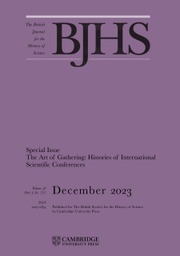This book traces the complex relations between ‘Spencerian Lamarckism and/or Neo-Lamarckism’ and the emerging ‘sciences of man’ in the second half of the nineteenth century, focusing on how particular models of evolution and heredity were taken up in neurology, psychology and sociology by John Hughlings Jackson, Théodule-Armand Ribot and Emile Durkheim respectively (p. xii). The book begins with two background chapters describing the early nineteenth-century theoretical framework of Jean-Baptiste Lamarck and the subsequent development and transfer of this framework (about fifty years later) into psychology and sociology by Herbert Spencer. The core of the book consists of three chapters centred around Jackson (1860s–1880s), Ribot (1870s–1890s) and Durkheim (1880s–1910s), with interspersed conceptual interludes on plasticity, hierarchy and collectivity, as well as a coda on Sigmund Freud, who claimed late in life that biological evolution could not do without the inheritance of acquired characters (p. 237).
The first chapter, although it nicely situates Lamarck in his political and institutional context, is a bit of an outlier: the works discussed were written a half-century before those of Spencer, who thus had a more direct influence on Jackson, Ribot and Durkheim. Beyond a particular model of heredity, what Lamarck and Spencer shared was a commitment to a ‘naturalized’ account of human behaviour that postulated a fundamental continuity between humans and other animals (p. 25). Thus the sentiment intérieur (inner feeling), which in Lamarck’s words ‘gives [a being] a very obscure notion of its existence’, is seen a common possession of mammals and possibly even vertebrates more generally (pp. 20–2).
Gissis also shows that Lamarck and Spencer both embraced the ‘conceptual package deal’ that she terms ‘the Cluster of Plasticity’, which involved a focus on environments and on the ability to shape and to respond to changes in those environments (pp. 81–2). On this point, Charles Lyell (in Britain) and Auguste Comte (in France), both writing in the 1830s, are missing links in Gissis’s story. Lyell argued that all naturalists endorsed the claim ‘that circumstances influence the habits, and that the habits may alter the state of the parts and organs’, merely insisting against Lamarck that such modifications of habits and organs have definite limits (Lyell, Principles of Geology, vol. 2, 1832, pp. 26–7). Comte, for his part, was the source of Spencer’s idea that ‘harmony between the living being and the corresponding milieu evidently characterizes the fundamental condition of life’, even claiming that biology needed a ‘general theory of organic milieux and their action on the organism’ (Comte, Cours de philosophie positive, vol. 3, 1838, pp. 289, 308).
Regarding the living being and its milieu, Gissis attributes to Spencer a ‘tripartite model’ that includes ‘[1] organism, [2] environment, and [3] their mutual interactions and the ensuing effects of these interactions’ (p. 45). Although Gissis criticizes scholars (including me) who have written about Spencer’s organism–environment dichotomy or his organism–environment framework, I am not sure what hangs on the distinction between a ‘two-factors’ approach (to borrow John Tyndall’s language), which merely implies ‘incessant interaction’, and a tripartite model, which explicitly includes that interaction (p. xi). Gissis does make the compelling point that, for Spencer, ‘none of the elements of the tripartite relationship was viewed as totally passive, with the frame of analysis both reciprocal and looping’ (p. 47). This emphasis on reciprocal activity contrasts with that of earlier scholars, who labelled Spencer an ‘externalist’ – that is, someone who explains ‘properties of organic systems in terms of properties of their environments’ (Peter Godfrey-Smith, Complexity and the Function of Mind in Nature, 1996, p. 30).
One key point of Gissis’s book is that Spencerian Lamarckism allowed scientists to build a bridge between individuals and social groups via ‘the notion of the inherited impact of a collectivity’s past generations’ (p. 253). This bridge was important for all three of Gissis’s focal actors. Jackson adopted Spencer’s idea of dissolution – evolution in reverse – in developing his theory of the nervous system and of neural pathologies. According to this theory, the nervous system has evolved to produce a layered hierarchy, with the higher centres ‘controlling, constraining, and suppressing activities of those beneath them’ (p. 103). Pathologies could then be conceptualized as dissolutions, in which the higher centers lose this control and the individual regresses to an earlier stage of nervous evolution. Ribot, who helped popularize Spencer in France and was also strongly influenced by Jackson’s theory, introduced the related idea of regression of will, ‘depicted as a move from the voluntary to the automatic’. For Ribot, consciousness was ‘a relativized point at one end of a continuum, at the other end of which lay unconscious states, habituated patterns’ and so on (p. 165). Durkheim likewise placed modern society at the end of an evolutionary continuum, viewing it as ‘more viable, stronger, and more integrated than traditional “simple and homogeneous” societies’ (p. 207). Against this evolutionary backdrop, the task of sociology was to study those relatively stable practices that constitute our social inheritance – practices viewed as (in Durkheim’s words) ‘collective habits … expressed in definite forms’ (p. 211 n.).
Gissis’s book attempts to cover a lot of ground: even leaving aside Lamarck and Freud, it spans almost sixty years from Spencer’s Principles of Psychology (1855) to Durkheim’s Elementary Forms of Religious Life (1912). Perhaps inevitably, then, it moves quickly and is often hard to follow. I would also have liked to hear more about some of the figures who appear only briefly in several chapters: Alfred Espinas, for instance, who seems to have been important for both Ribot and Durkheim. But overall, Gissis makes a convincing case that Spencerian Lamarckism was a fundamental framework for the human sciences as they emerged at the end of the nineteenth century in Britain and France.



